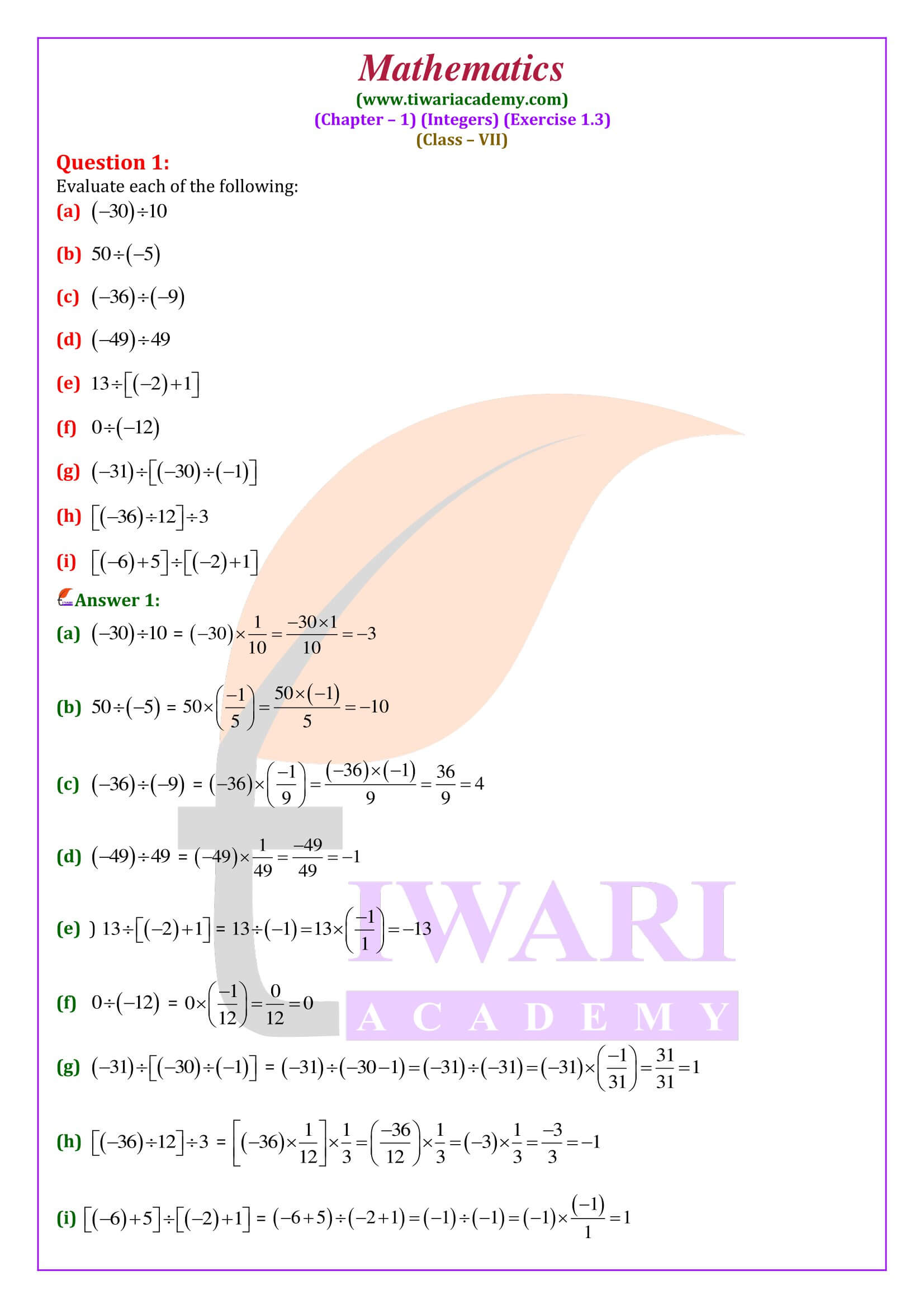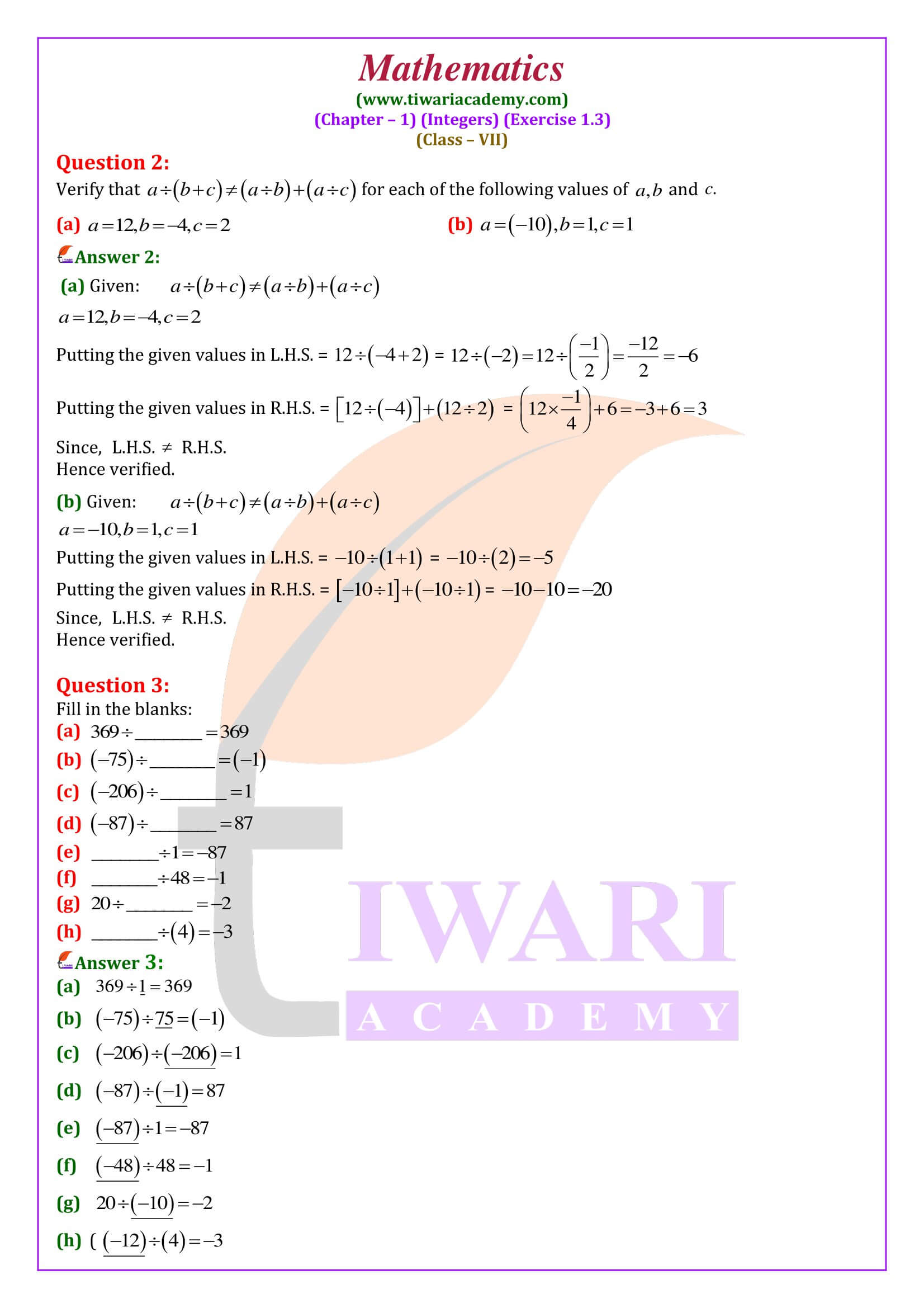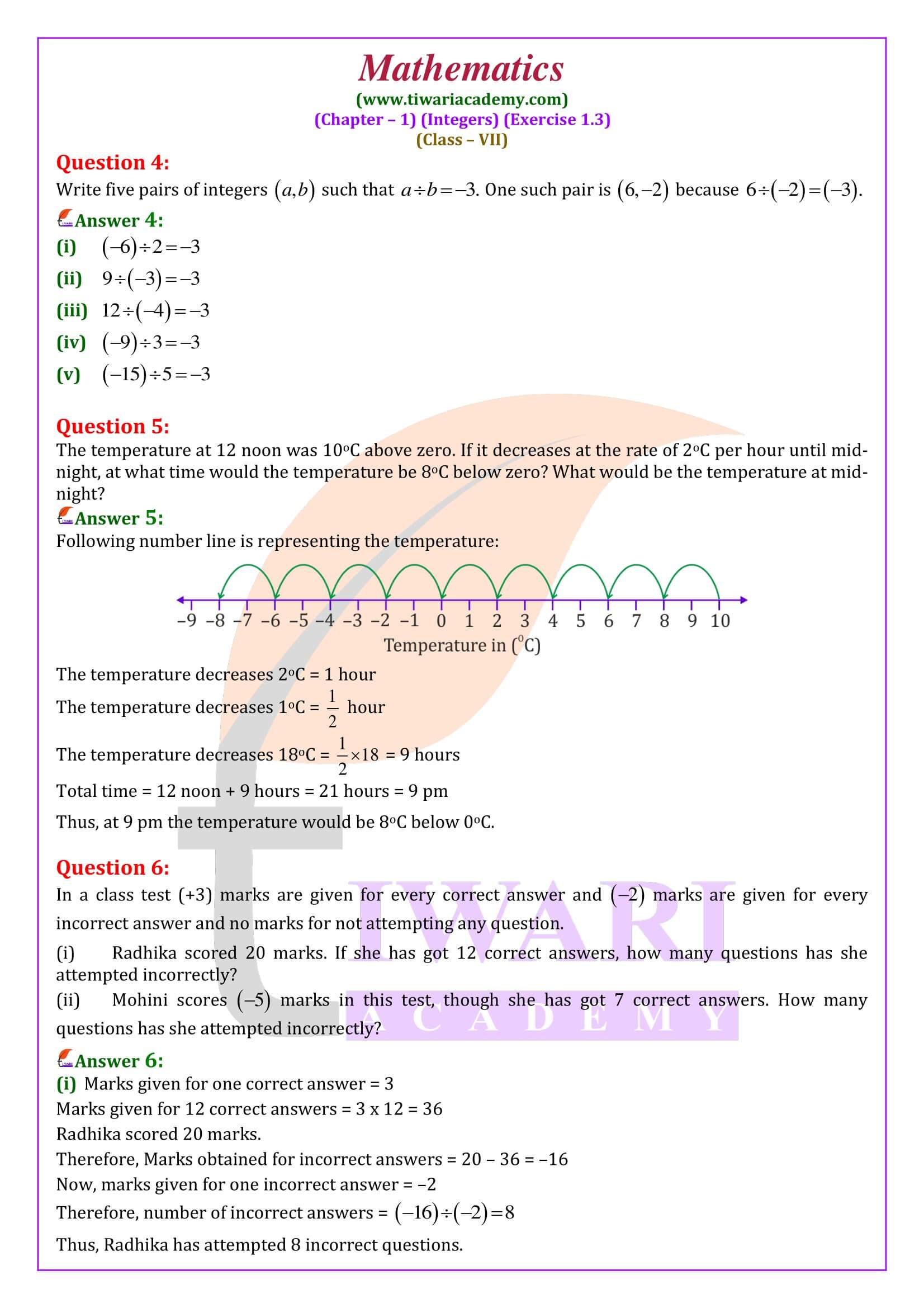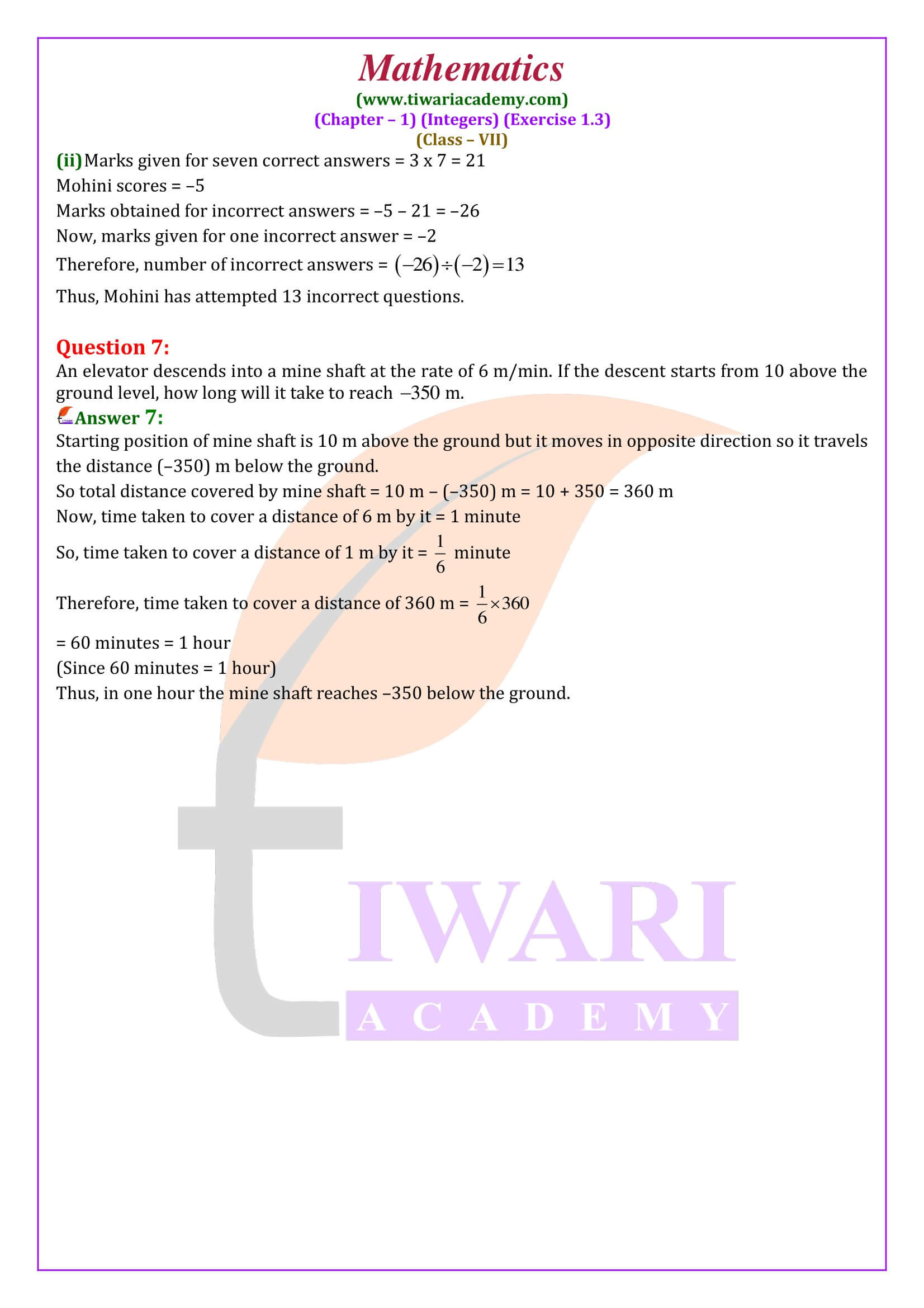NCERT Solutions for Class 7 Maths Chapter 1 Exercise 1.3 Integers Updated and Modified for New Session 2025-26 in Hindi and English Medium. The question answers explanation of ex. 1.3 class 7th Maths are revised according to new NCERT books for curriculum 2025-26.
NCERT Solutions for Class 7 Maths Exercise 1.3 Solution in Hindi and English Medium
| Class: 7 | Mathematics |
| Chapter: 1 | Exercise: 1.3 |
| Topic Name: | Integers |
| Session: | CBSE 2025-26 |
| Content: | NCERT Textbook’s Solution |
| Medium: | Hindi and English Medium |
Class 7 Maths Chapter 1 Exercise 1.3 Solution
All the questions are done by the subject experts step by step using easy methods. Class 7 math NCERT exercise 1.3 deals with the questions related to division of integers with practical examples based on daily life. Solution and Explanation videos help the students to understand the concept of the questions.
Class 7 Maths Chapter 1: Division of Integers
We know that division is an inverse process of multiplication.
Rule 1. For dividing one integer by the other, the two having unlike signs, we divide their values regardless of their signs and give a minus sign to the quotient.
Rule 2. For dividing one integer by the other having like signs, we divide their values regardless of their signs and give a plus sign to the quotient.
Class 7 Maths Exercise 1.3 Practice Questions
Evaluate: (i) (- 48) ÷ 12 (ii) 144 ÷ (- 16) (iii) (- 69) ÷ 23
We have:
(i) (- 48) ÷ 12 = -48/12 = – 4.
(ii) 144 ÷ (- 16) = 144/-16 = -9
(iii) (- 69) ÷ 23 = -69/23 = – 3.
An elevator descends into a mine shaft at the rate of 6 m/min. If the descent starts from 20 m above the ground level. How long will it take to reach – 370 m?
Let the point O denote the ground level.
Then, OA = 20 m and OB = – 370 m.
So, AB = lOA – OBl = l20 – (- 370)l = l20 + 370l = 390 m.
So, distance covered = 390 m.
Rate of descent = 6 m/min.
Time taken = 390/6 min = 65 min = 1 hr 5 min.
Evaluate: (i) 98 ÷ 14 (ii) (- 48) ÷ (- 16) (iii) (- 90) ÷ (- 15)
We have:
(i) 98 ÷ 14 = 98/14 = 7.
(ii) (- 48) ÷ (- 16) = -48/-16 = 3.
(iii) (- 90) ÷ (- 15) = -90/-15 = 6.
Class 7 Maths Chapter 1: Modulus of an Integer
The modulus of an integer a, denoted by IaI and is defined as lal = a, if a is positive or zero. – a, if a is negative. Thus, l6l = 6 and l-6l = – (- 6) = 6.
Distance between the Two Points
Let A and B be two points at distances a and b respectively from the origin. Then, we define AB = Ia – bI.
Class 7 Maths Exercise 1.3 Important Questions
How do you solve division of integers?
First, find the absolute values of the two integers. Next, divide the numbers or find their quotient. Finally, determine the final sign of the answer or quotient. Because we are dividing two integers with the same sign, the quotient will have a positive sign.
What will be the sign of the product, if we multiply 90 negative a integer and 9 positive integer?
We have – 90 and + 9
Now -90/+9 = -10
In a class test containing 20 questions, 4 marks are given for every correct answer and (- 2) marks are given for every incorrect answer. Ranjita attempts all question and 12 of her answers are correct. What is her total score?
Marks given for 1 correct answer = 4.
Marks given for 12 correct answers = (4 x 12) = 48.
Marks given for 1 incorrect answer = – 2.
Marks given for (20 – 12), i.e., 8 incorrect answers = (- 2) x 8 = 16.
Ranjita’s total score = 48 + (- 16) = 32.
Properties of Division of Integers
We know that division is an inverse process of multiplication.
Class 7 Maths Chapter 1 Rule 1. For division
I. If a and b are integers then (a ÷ b) is not necessarily an integer.
Examples(i) 16 and 5 are both integers, but (16 ÷ 5) is not an integer.
II. If a is an integer and a ≠ 0, then a ÷ a = 1.
Example:
(i) 16 ÷ 16 = 1.
(ii) (- 8) ÷ (- 8) = 1.
III. If a is an integer, then (a ÷ 1) = a.
Example: (i) 7 ÷ 1 = 7. (ii) (- 6) ÷ 1 = (- 6).
IV. If a is an integer and a ≠ 0, then (0 ÷ a) = 0 but (a ÷ 0) is not meaningful.
Example:
(i) 0 ÷ 6 = 0.
(ii) 0 ÷ (- 4) = 0.
(iii) 6 ÷ 0 is meaningless.
V. If a, b, c are integers, then (a ÷ b) ÷ c ≠ a ÷ (b ÷ c), unless c = 1. Thus, division on integers in not associative.
Example: Let a = – 8, b = 4 and c = – 2.
Then. (a ÷ b) ÷ c = {(- 8) ÷ 4} ÷ (- 2)
= (- 2) ÷ (- 2) = 1. a ÷ (b ÷ c)
= (- 8) ÷ {4 ÷ (- 2)}
= (- 8) ÷ (- 2)
= 4.
(a ÷ b) ÷ c ≠ a ÷ (b ÷ c).
However, if a = – 8, b = 4 and c = 1,
then (a ÷ b) ÷ c = {(- 8) ÷ 4)} ÷ 1
= (- 2) ÷ 1 = (- 2).
a ÷ (b ÷ c)
= (- 8) ÷ {4 ÷1} = (- 8) ÷ 4 = (- 2).
So, in this case, (a ÷ b) ÷ c = a ÷ (b ÷ c).
VI. If a, b, c are nonzero integers and a > b, then
(i) (a ÷ c) > (b ÷ c), if c is positive.
(ii) (a ÷ c) < (b ÷ c), if c is negative.
Example: (i) 27 > 18 and 9 is positive.
So, 27/9 > 18/9
So, (ii) 27 > 18 and (- 9) is negative.
So, 27/-9 < 18/-9
How much time required to solve exercise 1.3 of class 7th Maths?
Exercise 1.3 of class 7th Maths contains only seven questions and two examples (examples 6, 7). So, exercise 1.3 of class 7th Maths is not at all lengthy. It is a short exercise. Short answer type questions (1 mark or 2 marks) can also come from this exercise in the exams.
Are there any questions in exercise 1.3 of class 7th Maths that teacher can give in the unit tests?
There are three questions and two examples in exercise 1.3 of class 7th Maths that teacher can give in the unit test. These questions and examples are questions 1 (a), 5, 7, and examples 6, 7. These problems are most important. These problems of exercise 1.3 of class 7th Maths have more chances to come in the unit test compared to other problems of exercise 1.3 of class 7th Maths.
Is exercise 1.3 of class 7th Maths simple to solve and understand?
Exercise 1.3 of class 7th Maths is not very simple and not very hard to solve and understand. This exercise lies in the mid of simple and hard. Students find questions 1, 2, 3 of exercise 1.3 of class 7th Maths easy and questions 4, 5, 6, 7 exercise 1.3 of class 7th Maths tough. So, this exercise is moderate.
Is it possible to complete exercise 1.3 of class 7th Maths in 1-2 days?
Yes, it is possible to complete exercise 1.3 of class 7th Maths in 1-2 days because this exercise is not very lengthy. But, if concepts based on this exercise are not clear to students, they can’t complete exercise 1.3 of class 7th Maths in 1-2 days. To finish this exercise in 1-2 days, students must know all the concepts based on this exercise.
What concepts do students learn in exercise 1.3 of class 7th Maths?
The concepts that students learn in exercise 1.3 of class 7th Maths are:
Division of Integers
Properties of Division of Integers








